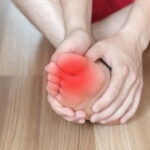
How a Podiatrist Can Help You Prevent Common Foot Problems
October 16, 2025
Understanding hcooch ch2 h2o: Structure, Reactions, Uses, and Safety
October 17, 2025Chronic care management involves ongoing medical attention for long-term health conditions. Conditions such as diabetes, heart disease, or asthma often require regular monitoring and consistent treatment over many years. By focusing on continuous support, chronic care management helps individuals maintain their daily routines and preserve their independence. Here are some ways strategies for managing chronic conditions have changed since the COVID pandemic:
Remote Patient Monitoring
Remote patient monitoring (RPM) uses digital technology to collect health information, such as vital signs and biometric data, from patients outside of traditional healthcare settings. Some people use blood pressure cuffs, glucometers, pulse oximeters, or digital weight scales at home. Results from these devices are automatically shared with healthcare teams, removing the need for frequent office visits.
With chronic care RPM, you and your provider receive consistent feedback on your condition. This stream of data helps build a complete picture of your health, showing patterns that may not be obvious in short office visits. If your blood pressure readings trend upward over several days, or your blood sugar consistently falls out of range, your provider can see this from the data dashboard and may contact you to discuss adjustments. Regular monitoring is valuable for managing conditions like hypertension, diabetes, congestive heart failure, and chronic kidney disease. It supports early detection of changes and supports decisions about your medication or care plan.
Virtual Communication
Virtual communication gives you direct access to your healthcare providers through secure digital channels. Some options include:
- Video visits
- Phone appointments
- Secure messaging
- Patient portals
These tools enable you to connect with your care team without needing to arrange transportation or take time off work. For many people with chronic illnesses, this makes it easier to ask for help when needed.
Virtual visits are often used to review test results, update your provider on new symptoms, and discuss medication changes. They also work well for routine check-ins or when you have follow-up questions after a hospital stay. These options help remove barriers to regular care, especially if you have mobility challenges or limited access to transportation.
Remote Therapeutic Monitoring
Remote therapeutic monitoring (RTM) is an aspect of home-based care that focuses on tracking elements like medication adherence, pain levels, physical activity, and respiratory system symptoms. RTM collects information you report yourself through a web portal or smart medical device, and it can make it easier for your care team to adjust your treatment plan. Understanding how you respond to therapy helps verify that treatment meets your needs.
Someone with asthma may use a digital inhaler that records how often and when it’s used. People managing musculoskeletal pain or recovering from surgery might answer daily questions about pain intensity, physical activity, or their ability to complete daily tasks. Self-reported data is sent to your provider’s dashboard, where they look for trends or address setbacks.
Work With a Chronic Care Specialist
Managing a long-term condition often requires guidance and regular support. Working alongside a provider who specializes in chronic care management helps you navigate everyday decisions and adjustments. A specialist helps you understand the details of your condition, answers your questions, and coordinates the different pieces of your treatment plan. To learn more about how chronic care management services support your health goals, contact a specialist today. Chronic care management involves ongoing medical attention for long-term health conditions. Conditions such as diabetes, heart disease, or asthma often require regular monitoring and consistent treatment over many years. By focusing on continuous support, chronic care management helps individuals maintain their daily routines and preserve their independence. Here are some ways strategies for managing chronic conditions have changed since the COVID pandemic:
Remote Patient Monitoring
Remote patient monitoring (RPM) uses digital technology to collect health information, such as vital signs and biometric data, from patients outside of traditional healthcare settings. Some people use blood pressure cuffs, glucometers, pulse oximeters, or digital weight scales at home. Results from these devices are automatically shared with healthcare teams, removing the need for frequent office visits.
With chronic care RPM, you and your provider receive consistent feedback on your condition. This stream of data helps build a complete picture of your health, showing patterns that may not be obvious in short office visits. If your blood pressure readings trend upward over several days, or your blood sugar consistently falls out of range, your provider can see this from the data dashboard and may contact you to discuss adjustments. Regular monitoring is valuable for managing conditions like hypertension, diabetes, congestive heart failure, and chronic kidney disease. It supports early detection of changes and supports decisions about your medication or care plan.
Virtual Communication
Virtual communication gives you direct access to your healthcare providers through secure digital channels. Some options include:
- Video visits
- Phone appointments
- Secure messaging
- Patient portals
These tools enable you to connect with your care team without needing to arrange transportation or take time off work. For many people with chronic illnesses, this makes it easier to ask for help when needed.
Virtual visits are often used to review test results, update your provider on new symptoms, and discuss medication changes. They also work well for routine check-ins or when you have follow-up questions after a hospital stay. These options help remove barriers to regular care, especially if you have mobility challenges or limited access to transportation.
Remote Therapeutic Monitoring
Remote therapeutic monitoring (RTM) is an aspect of home-based care that focuses on tracking elements like medication adherence, pain levels, physical activity, and respiratory system symptoms. RTM collects information you report yourself through a web portal or smart medical device, and it can make it easier for your care team to adjust your treatment plan. Understanding how you respond to therapy helps verify that treatment meets your needs.
Someone with asthma may use a digital inhaler that records how often and when it’s used. People managing musculoskeletal pain or recovering from surgery might answer daily questions about pain intensity, physical activity, or their ability to complete daily tasks. Self-reported data is sent to your provider’s dashboard, where they look for trends or address setbacks.
Work With a Chronic Care Specialist
Managing a long-term condition often requires guidance and regular support. Working alongside a provider who specializes in chronic care management helps you navigate everyday decisions and adjustments. A specialist helps you understand the details of your condition, answers your questions, and coordinates the different pieces of your treatment plan. To learn more about how chronic care management services support your health goals, contact a specialist today. Chronic care management involves ongoing medical attention for long-term health conditions. Conditions such as diabetes, heart disease, or asthma often require regular monitoring and consistent treatment over many years. By focusing on continuous support, chronic care management helps individuals maintain their daily routines and preserve their independence. Here are some ways strategies for managing chronic conditions have changed since the COVID pandemic:
Remote Patient Monitoring
Remote patient monitoring (RPM) uses digital technology to collect health information, such as vital signs and biometric data, from patients outside of traditional healthcare settings. Some people use blood pressure cuffs, glucometers, pulse oximeters, or digital weight scales at home. Results from these devices are automatically shared with healthcare teams, removing the need for frequent office visits.
With chronic care RPM, you and your provider receive consistent feedback on your condition. This stream of data helps build a complete picture of your health, showing patterns that may not be obvious in short office visits. If your blood pressure readings trend upward over several days, or your blood sugar consistently falls out of range, your provider can see this from the data dashboard and may contact you to discuss adjustments. Regular monitoring is valuable for managing conditions like hypertension, diabetes, congestive heart failure, and chronic kidney disease. It supports early detection of changes and supports decisions about your medication or care plan.
Virtual Communication
Virtual communication gives you direct access to your healthcare providers through secure digital channels. Some options include:
- Video visits
- Phone appointments
- Secure messaging
- Patient portals
These tools enable you to connect with your care team without needing to arrange transportation or take time off work. For many people with chronic illnesses, this makes it easier to ask for help when needed.
Virtual visits are often used to review test results, update your provider on new symptoms, and discuss medication changes. They also work well for routine check-ins or when you have follow-up questions after a hospital stay. These options help remove barriers to regular care, especially if you have mobility challenges or limited access to transportation.
Remote Therapeutic Monitoring
Remote therapeutic monitoring (RTM) is an aspect of home-based care that focuses on tracking elements like medication adherence, pain levels, physical activity, and respiratory system symptoms. RTM collects information you report yourself through a web portal or smart medical device, and it can make it easier for your care team to adjust your treatment plan. Understanding how you respond to therapy helps verify that treatment meets your needs.
Someone with asthma may use a digital inhaler that records how often and when it’s used. People managing musculoskeletal pain or recovering from surgery might answer daily questions about pain intensity, physical activity, or their ability to complete daily tasks. Self-reported data is sent to your provider’s dashboard, where they look for trends or address setbacks.
Work With a Chronic Care Specialist
Managing a long-term condition often requires guidance and regular support. Working alongside a provider who specializes in chronic care management helps you navigate everyday decisions and adjustments. A specialist helps you understand the details of your condition, answers your questions, and coordinates the different pieces of your treatment plan. To learn more about how chronic care management services support your health goals, contact a specialist today.
- Navigating Healthy Weight Loss During Life Changes
- Candizi – Where Wellness Meets Delicious Simplicity
- EO PIS – Executive Operations Performance Indicator System Explained
- A 2022. Évi Téli Paralimpia Megnyitó Ceremóniája – A Grand Opening Beyond Sports
- Understanding the Services Offered at Aesthetic Centers



